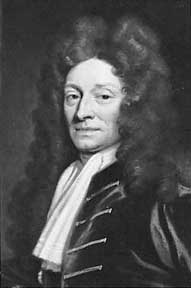Christopher Wren

1632-1723
| Sir
Christopher Wren, (born Oct. 20, 1632, East Knoyle,
Wiltshire,
Eng.—died Feb. 25, 1723, London), designer, astronomer, geometrician,
and the greatest English architect of his time. Wren designed 53 London churches, including St. Paul’s Cathedral, as well as many secular buildings of note. He was a founder of the Royal Society (president 1680–82), and his scientific work was highly regarded by Sir Isaac Newton and Blaise Pascal. He was knighted in 1673. - Encyclopaedia Britannica: Sir Christopher Wren (online March 2016) |
| Christopher Wren was born on 20
October 1632 in East Knoyle, Wiltshire,
where his father was rector. His father later moved to Windsor and Wren
was educated at Westminster School and then Oxford University. He
showed an early talent for mathematics and enjoyed inventing things,
including an instrument for writing in the dark and a pneumatic
machine. In 1657, Wren was appointed professor
of astronomy at Gresham
College in London and four years later, professor of astronomy at
Oxford. In 1662, he was one of the founding members of the Royal
Society, along with other mathematicians, scientists and
scholars, many
of whom were his friends. Wren's interest in architecture developed from his study of physics and engineering. In 1664 and 1665, Wren was commissioned to design the Sheldonian Theatre in Oxford and a chapel for Pembroke College, Cambridge and from then on, architecture was his main focus. In 1665, Wren visited Paris, where he was strongly influenced by French and Italian baroque styles. In 1666, the Great Fire of London destroyed much of the medieval city, providing a huge opportunity for Wren. He produced ambitious plans for rebuilding the whole area but they were rejected, partly because property owners insisted on keeping the sites of their destroyed buildings. Wren did design 51 new city churches, as well as the new St Paul's Cathedral. In 1669, he was appointed surveyor of the royal works which effectively gave him control of all government building in the country. He was knighted in 1673. In 1675, Wren was commissioned to design the Royal Observatory at Greenwich. In 1682, he received another royal commission, to design a hospital in Chelsea for retired soldiers, and in 1696 a hospital for sailors in Greenwich. Other buildings include Trinity College Library in Cambridge (1677 - 1692), and the facade of Hampton Court Palace (1689 - 1694). Wren often worked with the same team of craftsmen, including master plasterer John Groves and wood carver Grinling Gibbons. Wren died on 25 February 1723. His gravestone in St Paul's Cathedral features the Latin inscription which translates as: 'If you seek his memorial, look about you.' - BBC:
Sir Christopher Wren (1632 - 1723) (online March 2016)
|